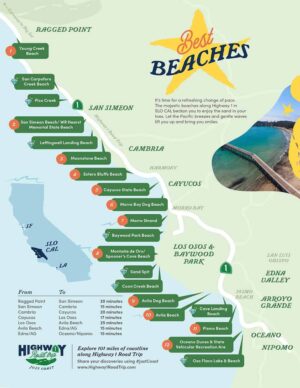Cast a line into the sparkling Pacific as waves lap at your feet and seabirds soar overhead. This everyday magic unfolds along the Central Coast’s Highway 1, where 100 miles of stunning coastline from Cambria to Pismo Beach offers California’s best saltwater fishing.
Escape to uncrowded beaches perfect for surf fishing during misty mornings or golden sunsets when catches of barred surfperch and halibut are most memorable. Low tide reveals hidden rockfishing treasures, while historic wooden piers in Morro Bay and Cayucos offer license-free fishing ideal for family outings. These timeworn structures have witnessed generations of anglers seeking both catch and connection.
Beyond the ocean, tranquil freshwater havens like Lopez Lake and Oso Flaco Lake to the south, or Whale Rock Reservoir near Cambria offer peaceful alternatives. For true solitude, discover Santa Margarita Lake, an off-the-beaten-path gem few tourists ever find.
Kayakers can glide through clear waters amid kelp forests teeming with lingcod and cabezon, accompanied only by paddle splashes and distant sea lions. Bring your own or rent locally in Avila Beach, while friendly charters stand ready for those seeking deeper waters and bigger catches.
The Central Coast’s reputation draws serious anglers to tournaments like the Central Coast Slamdown and Estero Fishing Challenge near Spooner’s Cove, but there’s always plenty for everyone. Before starting your adventure, check California Beach Fishing Guidelines for license requirements and restrictions. Visit Virg’s Landing in Morro Bay or Patriot Sportfishing in Avila Beach for licenses and expert tips that might lead to your best catch yet.
Explore Fishing Along Highway 1
Types of Fishing Along Highway 1
Surf Fishing
Feel the sand between your toes as you cast into the rolling Pacific waves. Highway 1 offers some of the best surf fishing opportunities on the California Coast. From the solitude of San Carpoforo Creek near Ragged Point to the expansive shores of Oceano Dunes, you’ll find miles of uncrowded beaches where barred surfperch, halibut, rockfish and croaker await just beyond the breakers.
The best surf fishing spots along Highway 1 include San Simeon’s golden shores, Cambria’s picturesque Moonstone Beach, Los Osos’ hidden gem at Sandspit Beach and the seemingly endless stretch of sand at Oceano Dunes. Early mornings and evening hours typically provide the most productive fishing, when the changing light keeps most beach-goers away and fish move closer to shore.
Don’t forget your California fishing license before heading out—you’ll need one for all surf fishing along Central Coast California beaches. The investment is well worth it when you’re reeling in dinner while watching dolphins play offshore.
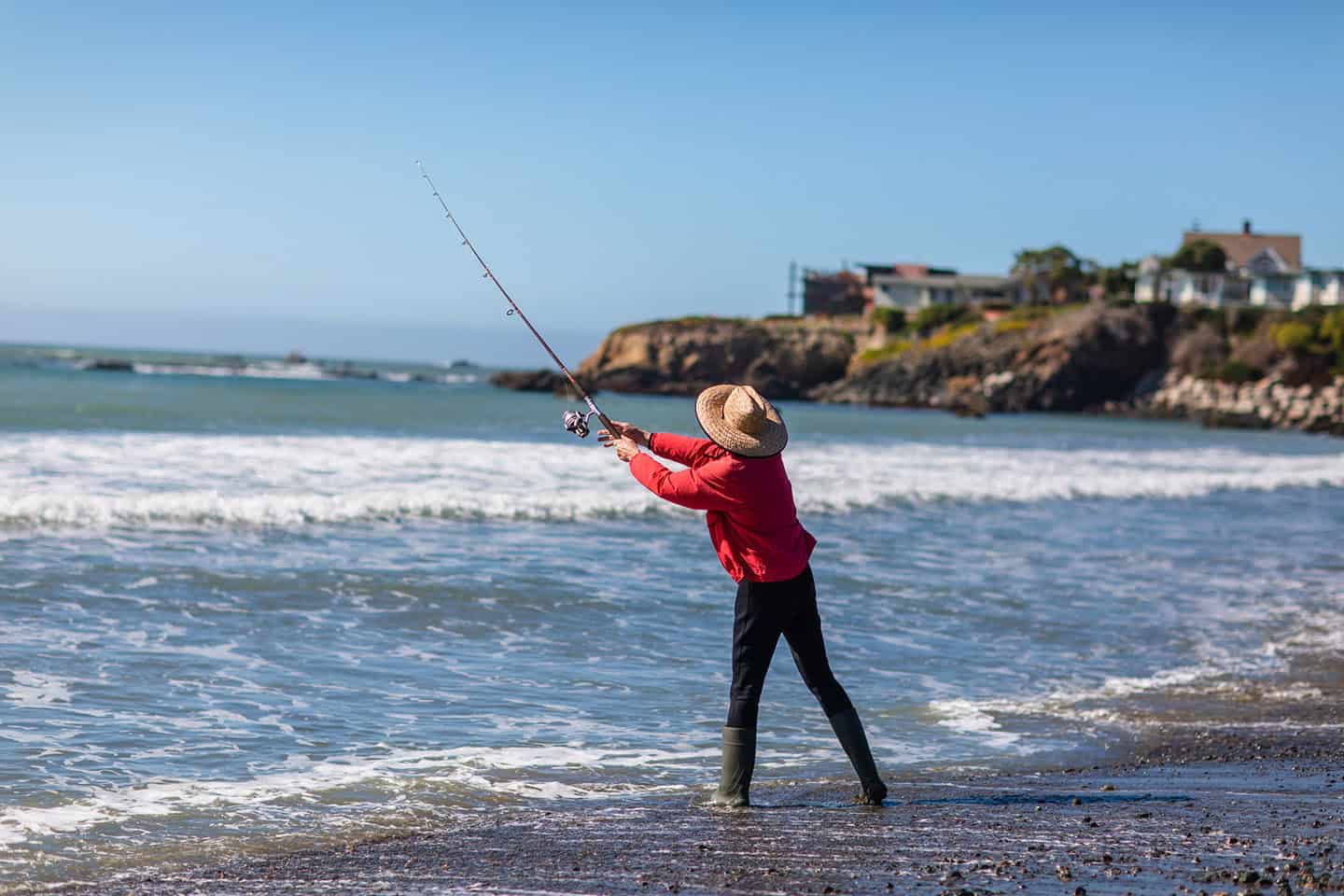
Pier Fishing
Looking for a no-fuss fishing experience that’s perfect for everyone from first-timers to seasoned anglers? The historic piers dotting Highway 1 offer license-free fishing with panoramic ocean views. These wooden structures extend your reach into deeper waters where various species thrive.
Cast your line from San Simeon Pier where the protective cove creates calm conditions perfect for families. The charming Cayucos Pier stretches 982 feet into the Pacific, offering ample room for anglers to spread out. Down the coast, Avila Beach’s pier and the working Harford Pier at Port San Luis welcome fishers of all skill levels.
You’ll typically find perch, mackerel, jacksmelt and even the occasional halibut or shark from these worn wooden structures. The best part? There’s no fishing license required when casting from public piers, making them perfect impromptu stops during your Highway 1 adventure.
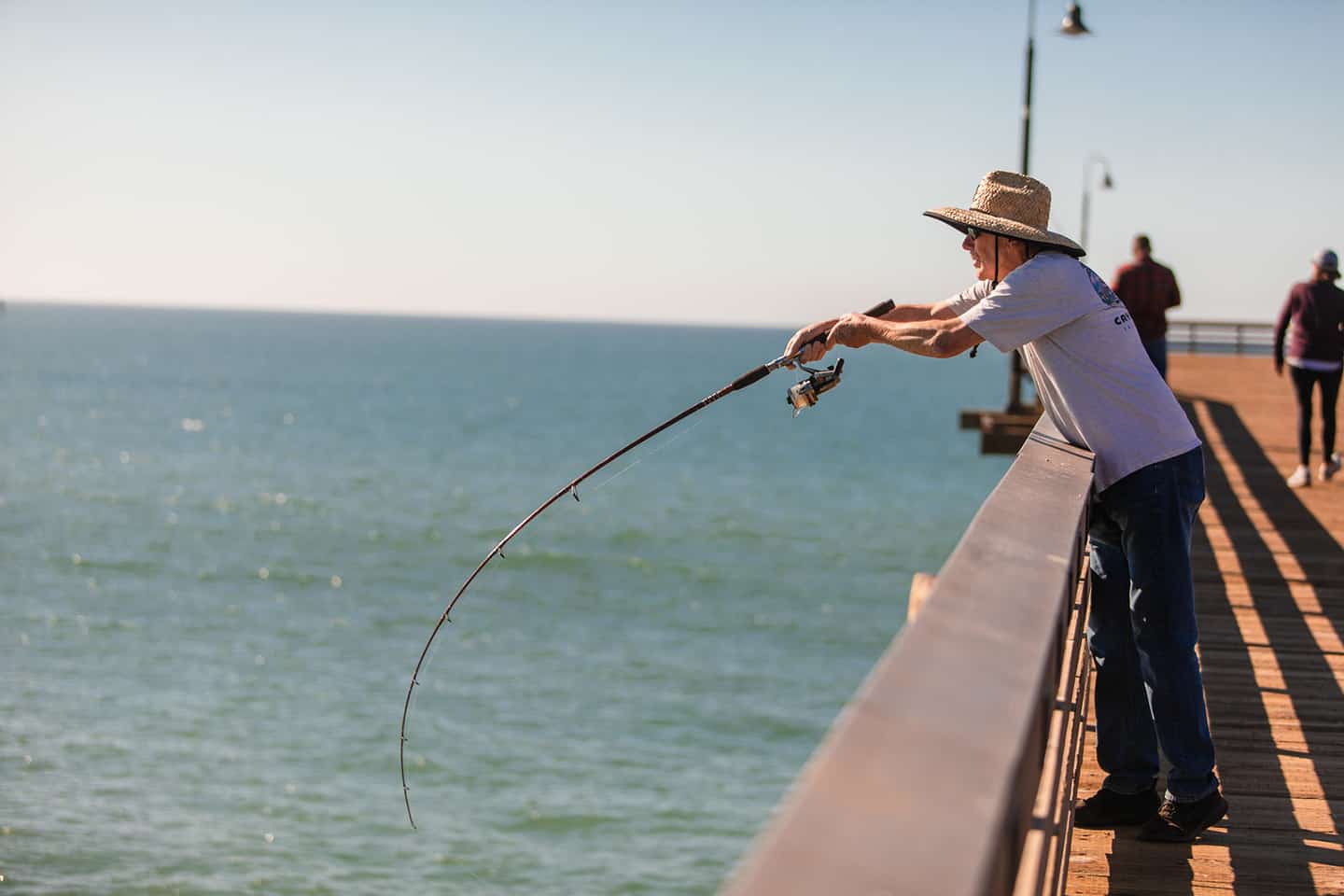
Kayak Fishing
For adventurous anglers seeking closer communion with the Pacific, kayak fishing Central Coast California waters delivers unmatched access to fish-rich environments beyond the surfline. Launch from protected coves like Leffingwell Landing in Cambria, the shelter of Spooner’s Cove, wind-protected Arroyo Laguna or the calm Olde Port Beach in Avila.
From your floating perch, you’ll glide silently over kelp forests and rocky reefs where rockfish, lingcod, cabezon and halibut hide. The peaceful waters near Port San Luis offer beginner-friendly conditions, while more experienced paddlers can venture further to find untapped fishing grounds.
Don’t own your own kayak? Both Central Coast Kayaks and Avila Beach PaddleSports offer quality rentals along with local knowledge about current conditions and productive fishing spots. Remember that kayak fishing requires a standard California fishing license, but the unique perspective and access is well worth it.
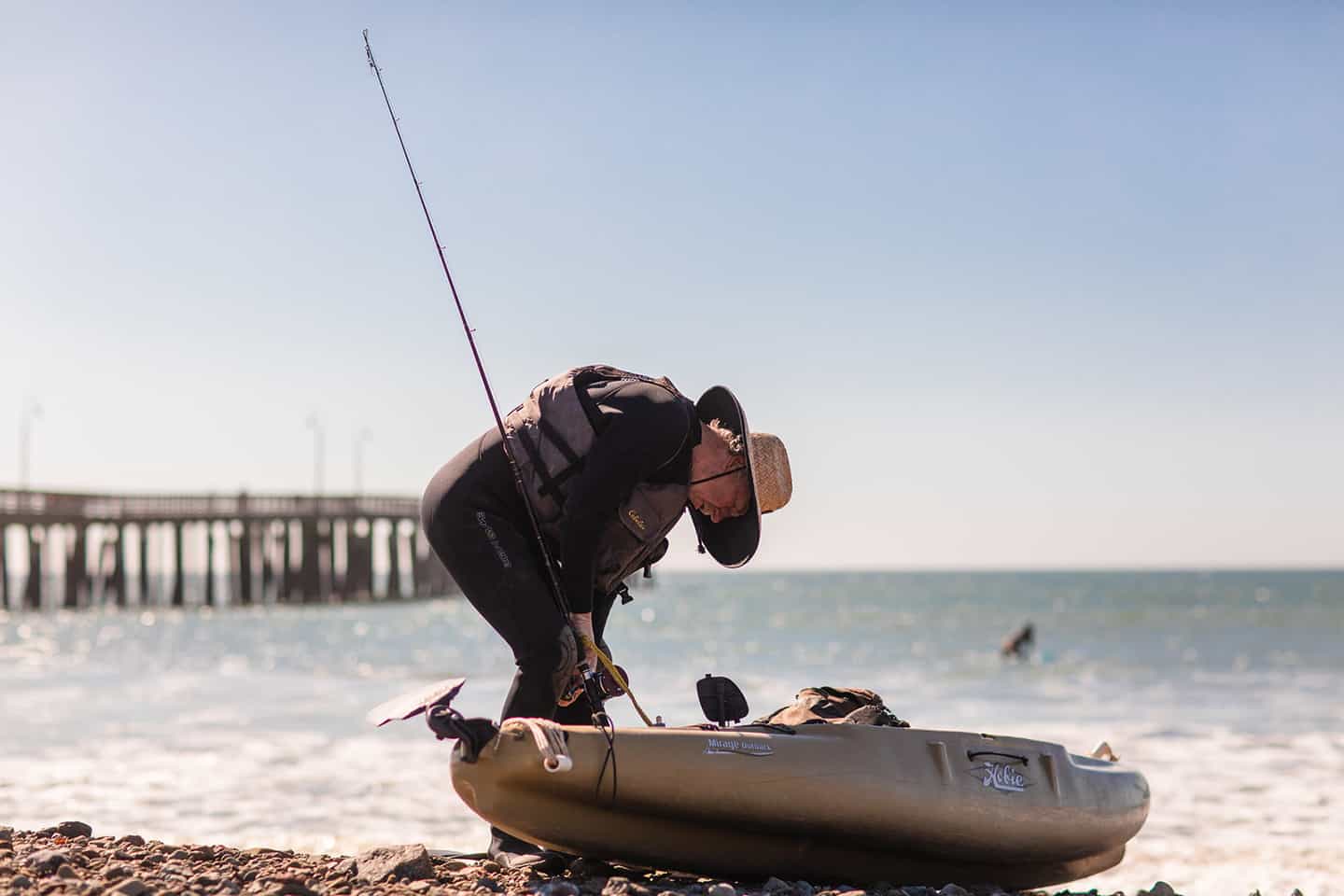
Deep Sea & Charter Fishing
When the call of deeper water beckons, Highway 1’s charter boats stand ready to take you where the big ones lurk. Departing from the protected harbors of Avila Beach and Morro Bay, these guided excursions offer access to offshore fishing grounds teeming with rock cod, albacore, halibut and seasonal salmon runs.
Patriot Sportfishing in Avila Beach offers half-day and full-day trips with all equipment provided—perfect for travelers who want the deep-sea experience without hauling their own gear. In Morro Bay, the legendary Virg’s Landing has been connecting anglers with impressive catches since 1953.
These professional captains bring generations of local knowledge to your fishing adventure, putting you directly on top of productive underwater structures and migration routes you’d likely never find on your own. While more expensive than shore-based options, the potential for trophy-sized catches and the breathtaking offshore views of the Highway 1 coastline create memories worth every penny.
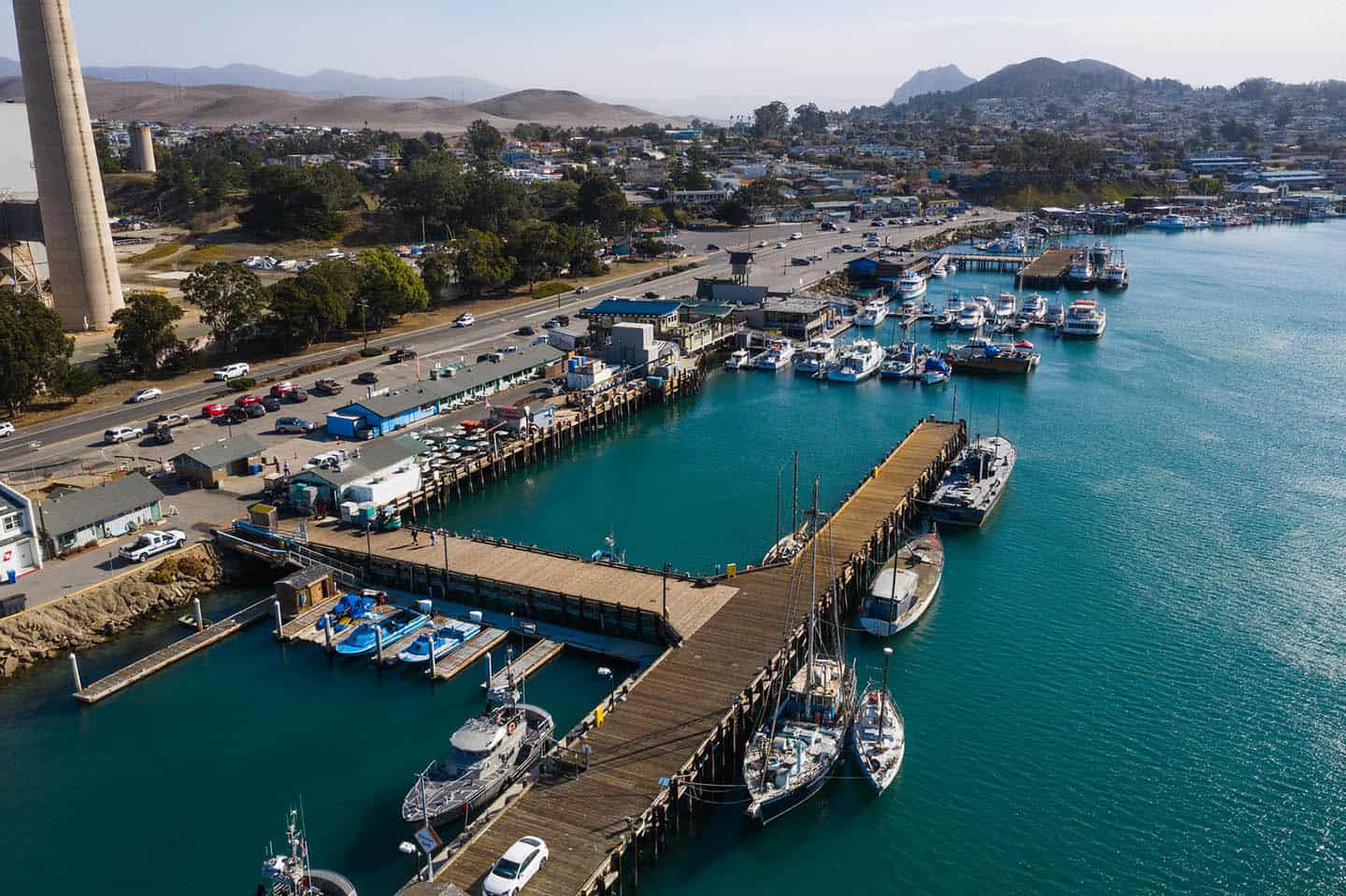
Freshwater / Lake Fishing
When ocean winds kick up or you’re craving a change of pace, Highway 1’s freshwater fishing offers peaceful alternatives just minutes from the coast. The region’s serene lakes provide year-round opportunities for bass, catfish, bluegill and stocked trout in picturesque settings.
Lopez Lake near Arroyo Grande spans 1,000 acres with numerous coves and inlets to explore.
Whale Rock Reservoir near Cayucos offers shoreline fishing for those seeking quiet solitude. Down south, the serene Oso Flaco Lake near Nipomo provides a unique freshwater fishing experience amid coastal dunes.
Many of these lakes offer amenities like kayak rentals, hiking trails and marina launches to enhance your fishing day. While the ocean might draw most visitors to Highway 1, these freshwater gems provide welcome diversity to your fishing portfolio—and often more consistent catch rates when coastal conditions aren’t cooperating.
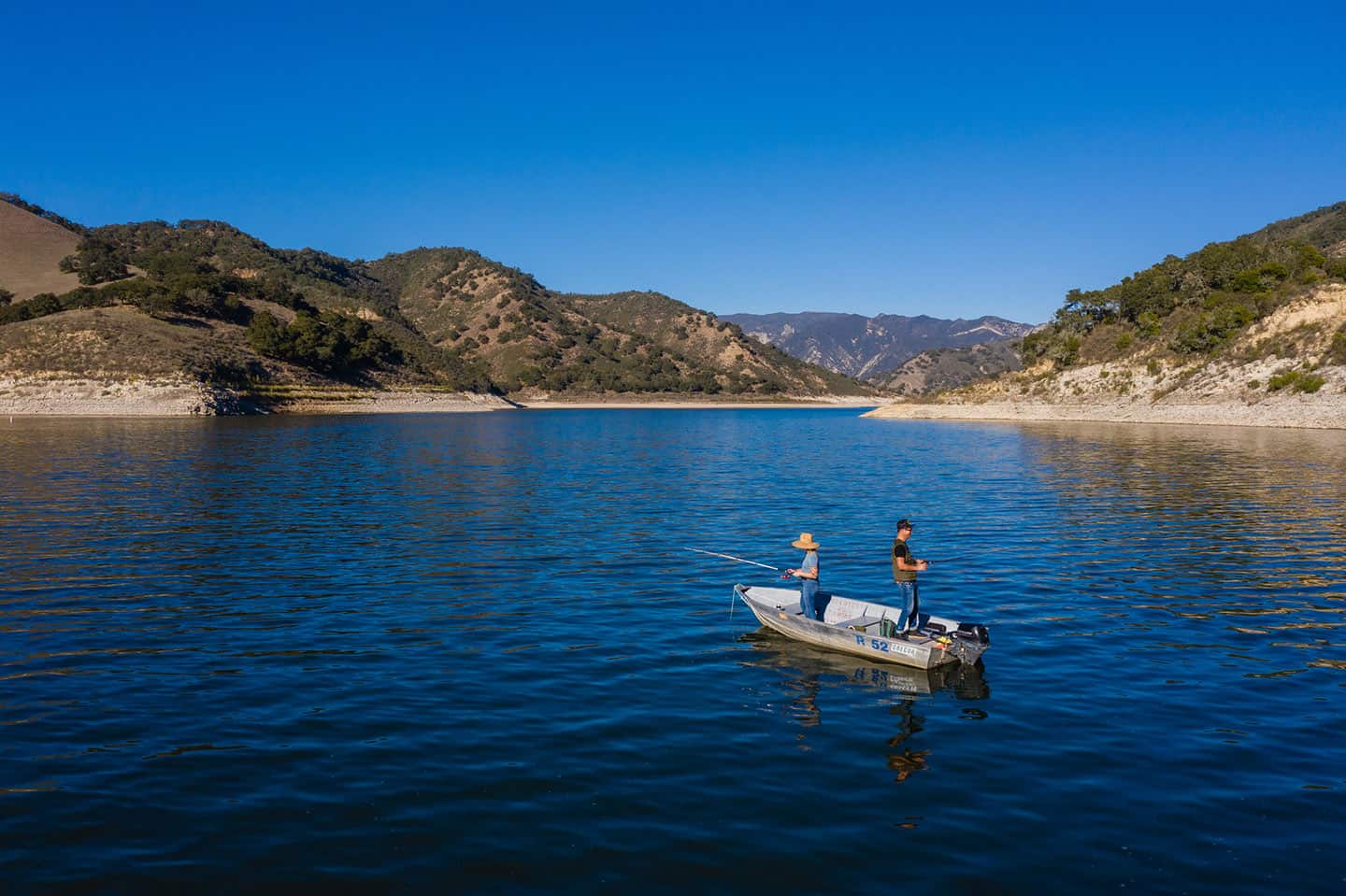
Where to Fish by Location
Ragged Point & San Simeon
San Carpoforo Creek (Ragged Point)
Craving a slice of fishing paradise away from the crowds? San Carpoforo Creek drains into the Pacific Ocean north of San Simeon, on the way toward Ragged Point. This magical spot connects to the Monterey Bay National Marine Estuary—a veritable underwater treasure chest of Central Coast California marine life. As the seasons shift, so does this dynamic creek, sometimes forming a peaceful lagoon on the beach and other times rushing directly into the ocean’s embrace.
When conditions align perfectly, you’ll find steelhead trout slicing through these waters—no small wonder why the California Department of Fish and Game considers San Carpoforo one of the area’s most significant steelhead spawning streams. After you’ve landed your catch, kick back on the wide, unspoiled beach at the rivermouth where the only footprints might be your own. Finding this secluded spot is part of the adventure: cruise Highway 1 about eight miles north of Piedras Blancas Light Station, looking for 18550 Cabrillo Highway on the east side. The entrance to your fishing sanctuary waits directly across on the western side.
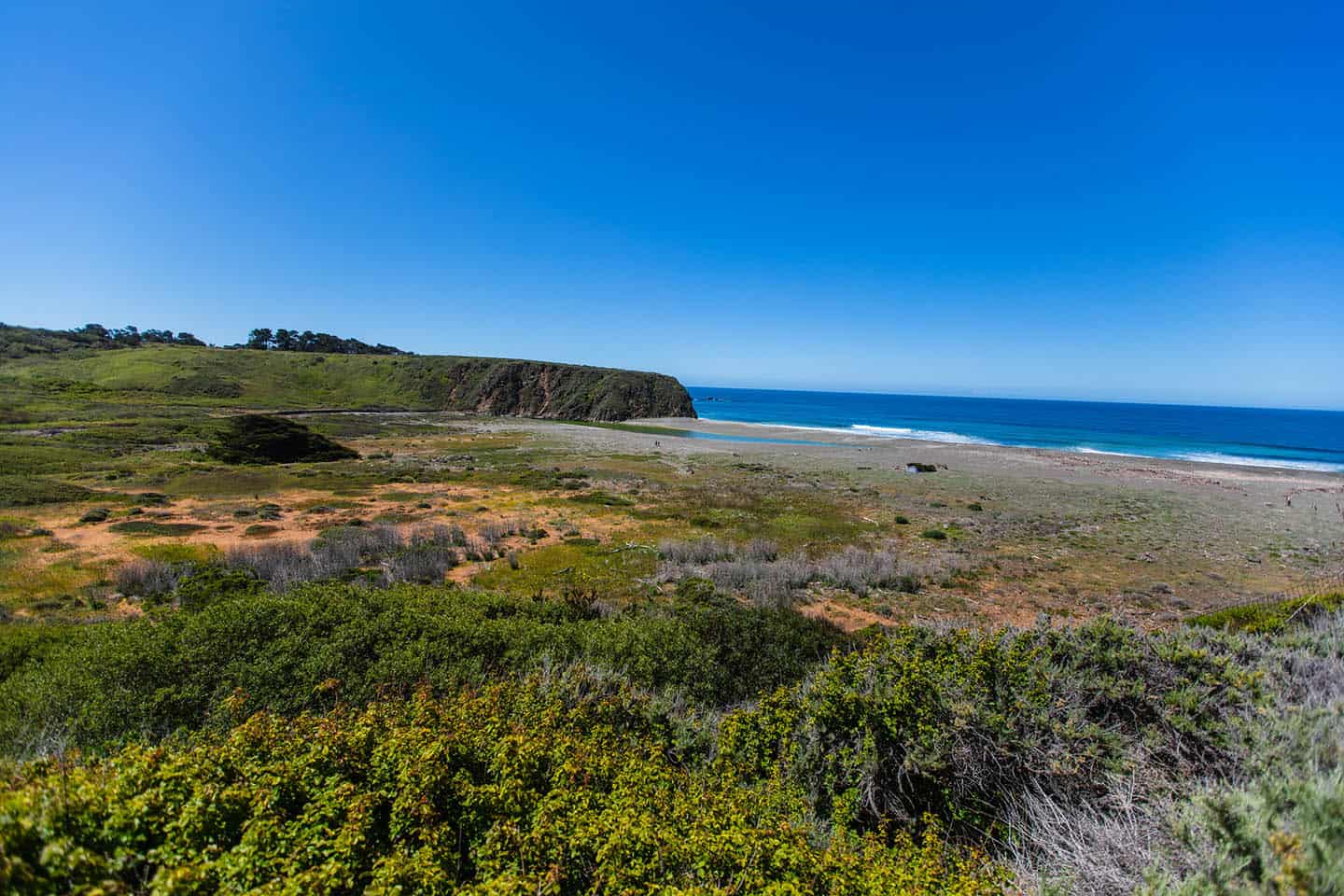
San Simeon Bay Pier
Step back in time at San Simeon Cove, where the historic pier once welcomed precious cargo for William Randolph Hearst’s legendary estate. Today, instead of ancient art and tapestries, you’ll be hauling in your own treasures from the sea. Unlike busier fishing spots along Highway 1, this beautifully positioned pier remains one of the coast’s best-kept secrets, with gentle surf thanks to the protective curve of the cove.
Take your time wandering the scenic beach before settling in on the 850-foot pier. Your patience might reward you with flatfish like sand dabs, sole and prized halibut. When summer warmth bathes the coast, watch for migratory visitors like mackerel, striped seaperch and jacksmelt dancing below the surface. Spring brings special opportunities—try bloodworms, lugworms or gulp worms in shallow, sun-warmed spots for sand dabs and surfperch. Families with little anglers will especially appreciate this spot; after the excitement of casting and reeling, little feet can splash in the gentle waves while you soak up California sunshine. Before heading home, pop into the Coastal Discovery Center just steps away to enrich your day with stories of San Simeon Bay’s natural and cultural heritage.
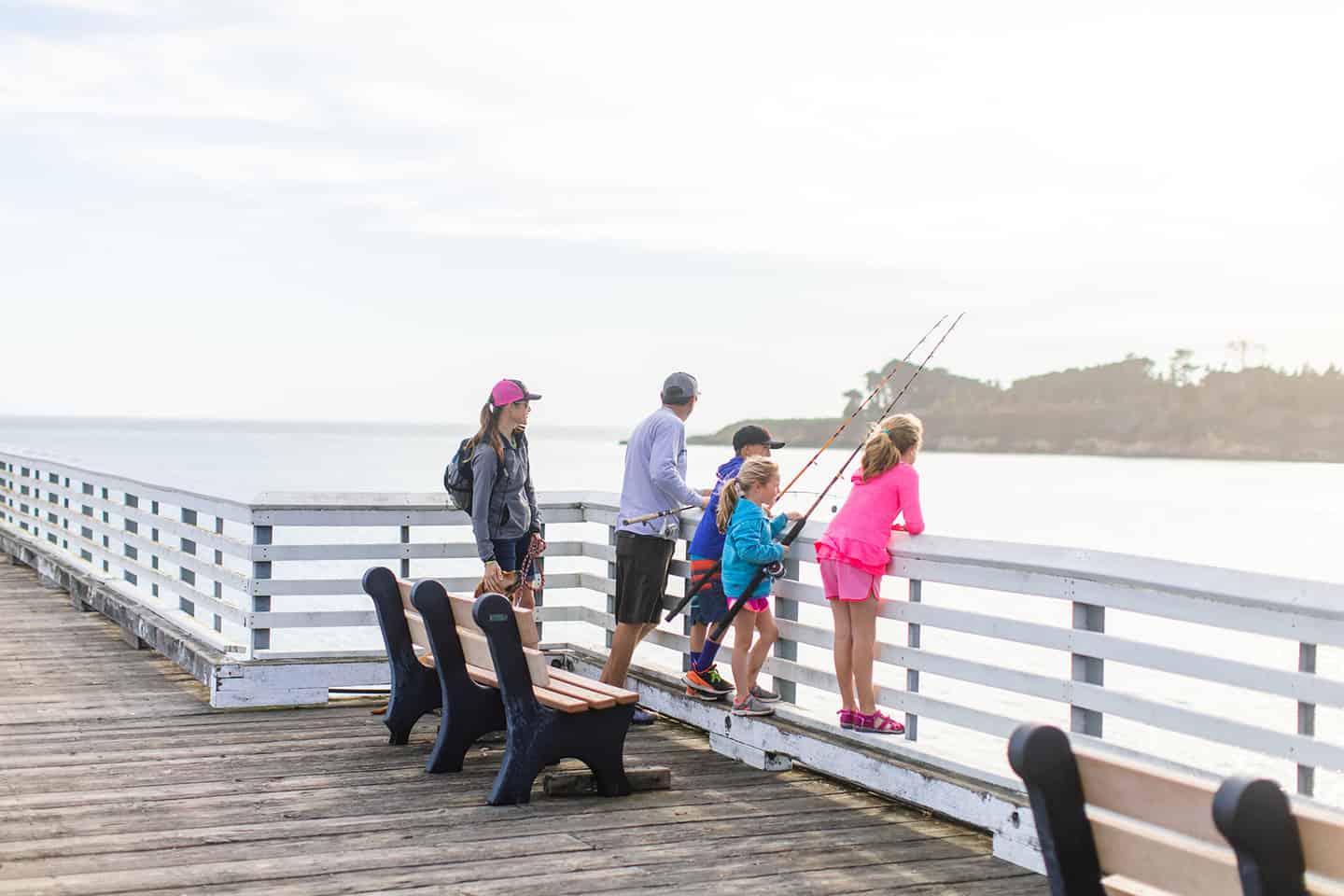
Arroyo Laguna (just north of San Simeon Pier)
Looking for more adventure? Arroyo Laguna Beach at Oak Knoll Creek’s mouth offers another perfect California Coast fishing spot within Hearst San Simeon State Park. While colorful kiteboards and windsurfers might catch your eye, kayak anglers know this spot holds underwater treasures. Push off into these waters and you might battle impressively sized lingcod or vibrant vermillion rockfish.
Finding your launch point is a breeze—drive north on Highway 1 about two miles past Hearst Castle’s entrance and watch for a small pullover after crossing Oak Knoll Creek bridge. The smooth, sandy beach makes launching your kayak effortless. When your arms need a rest, beach your kayak and enjoy a picnic lunch near the creek mouth, or stretch your legs with a hike southward. Just remember you’re sharing this stretch of coast with the magnificent elephant seals—respect their space, especially from December through April when viewing access is limited. For a closer encounter with these fascinating marine mammals, continue your Highway 1 journey to the Piedras Blancas Elephant Seal Rookery.
Kayak fishing enthusiasts should double back to Old San Simeon and San Simeon Bay—beyond the already fantastic pier fishing, you’ll find perfect conditions for paddle-powered angling adventures.
For the purest surf fishing experience, head to “new” San Simeon where the stretch of golden sand running alongside the oceanfront hotels offers miles of prime territory. North and south of the Cavalier Resort on Hearst Drive, you’ll find consistently good fishing for barred surfperch and white croaker throughout the year. Here’s a local secret that’ll save you cash: skip the bait shop and dig for “sand fleas” in the sand above the high tide line. These inch-long creatures resembling tiny shrimp are irresistible to local fish—just be careful handling them as they can nip at fingers! Experienced local anglers swear by an old-fashioned #6 Carolina rig when fishing these beaches. If the sand fleas are playing hard to get, a simple perch grub lure works wonders too.
Between casts, lift your gaze to the horizon where the sea puts on a free show—the graceful spouts of migrating whales, playful dolphins or curious sea otters might join you for a day of authentic Highway 1 fishing

Cambria
Moonstone Beach
Long strolls along this gem of a coastline reveal not just beautiful stones but prime surf fishing opportunities for anglers seeking that peaceful Highway 1 experience. The wide stretch of shoreline offers easy parking and direct beach access that’s perfect for a day of fishing. Cast your line during the incoming tide or search for small troughs in the sand where barred surfperch congregate, waiting for your bait.
The rocky areas at both the northern and southern ends of Moonstone Drive provide excellent spots for targeting rockfish and greenling. Just remember to exercise caution—these rocks can become slippery with the dance of incoming waves, and the tides here change quickly like much of the California Coast fishing terrain. Pack light, wear shoes with good grip and keep an eye on the ocean’s rhythm for a safe and productive day.
Between fishing sessions, take time to marvel at the wealth of smooth moonstones that give this beach its name—each one unique, just like the fishing memories you’ll create here along Central Coast California’s stunning shoreline.
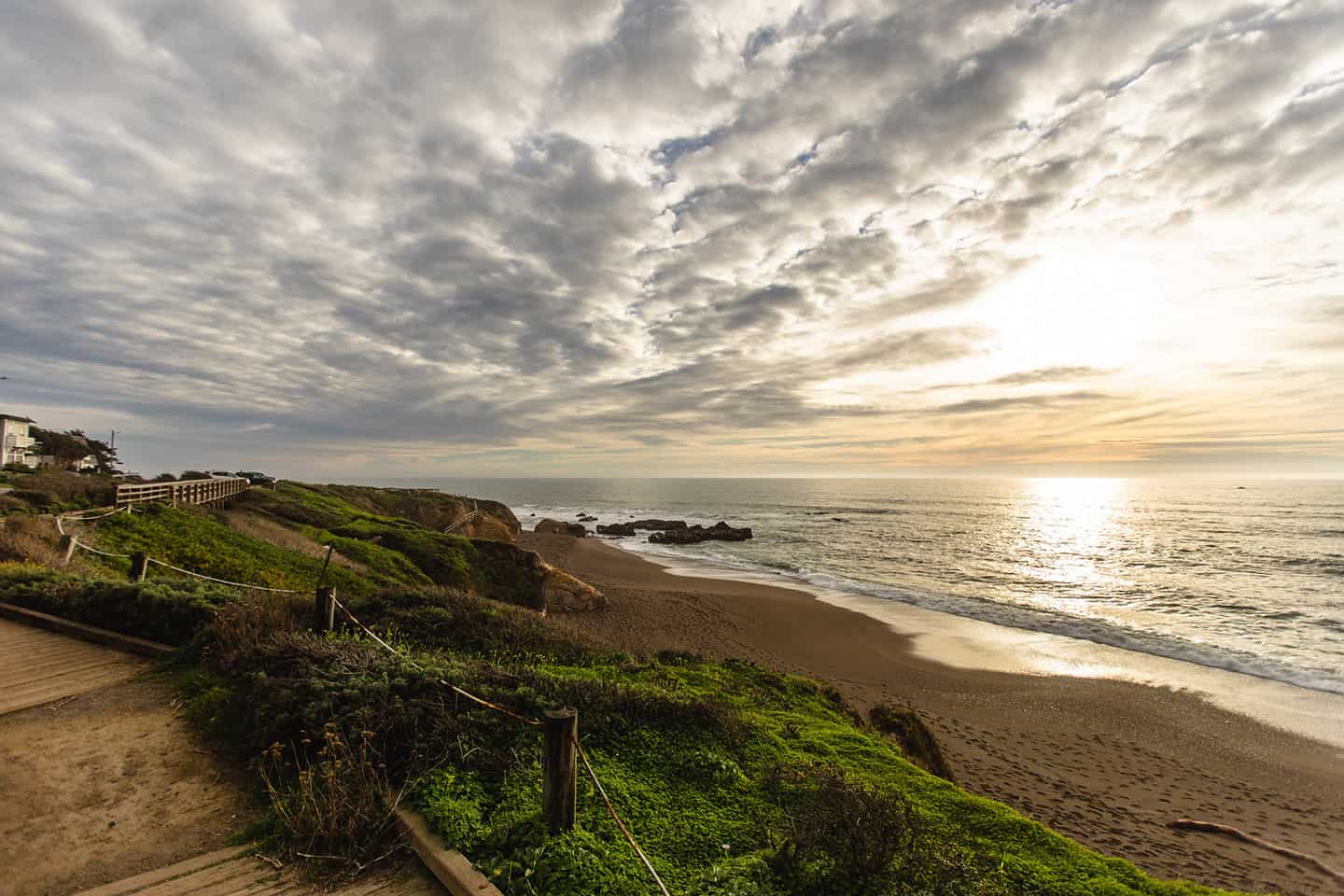
Leffingwell Landing
Tucked at the north end of Moonstone Drive, this protected cove serves double-duty as both a scenic fishing spot and one of the area’s premier kayak launch sites. While the beach area here is limited, the protective headland creates calm waters that kayak anglers particularly appreciate when conditions elsewhere turn rough.
From your kayak, you’ll access productive fishing grounds where lingcod, cabezon, rockfish and occasional halibut patrol near submerged rock formations. Even novice paddlers find these protected waters manageable, making it an ideal starting point for those new to kayak fishing Central Coast California waters.
The modest parking area fills quickly on summer weekends, so arrive early to secure your spot at this beloved local launching point. Pack a thermos of coffee and witness the morning fog lift to reveal stunning views of this rugged stretch of Highway 1 fishing paradise.
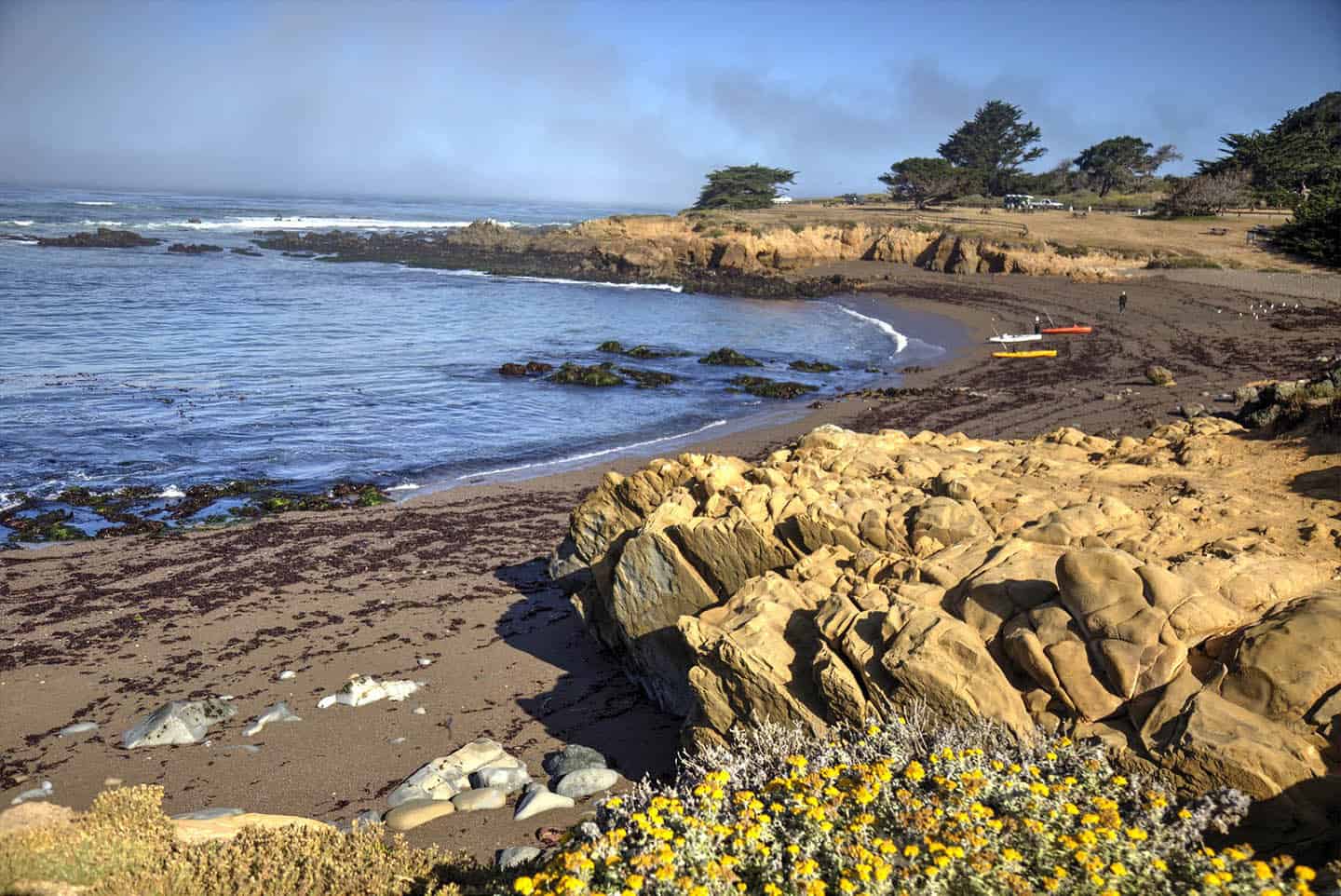
Cayucos
Cayucos Pier
This charming Cayucos landmark stretches nearly a thousand feet into the Pacific, offering ample space for casting without the crowds you might find at better-known fishing destinations. Like all public piers along Highway 1, no fishing license is required here—making it perfect for spontaneous stops during your coastal journey.
Regular Cayucos Pier catches include jacksmelt, surfperch, mackerel, rays and the occasional prized halibut. The pier’s extensive length means you can find your own perfect spot, whether you prefer the shallower waters near shore or the deeper haunts at the pier’s end where larger species often lurk.
Local tip: Bait shops in the immediate area are limited, so come prepared with your gear or stock up in Morro Bay before heading north. The Cayucos Pier shines brightest at dawn and dusk when feeding activity peaks and the golden California light transforms the old wooden structure into a photographer’s dream. Families and beginning anglers particularly appreciate the pier’s stable platform and relaxed atmosphere.
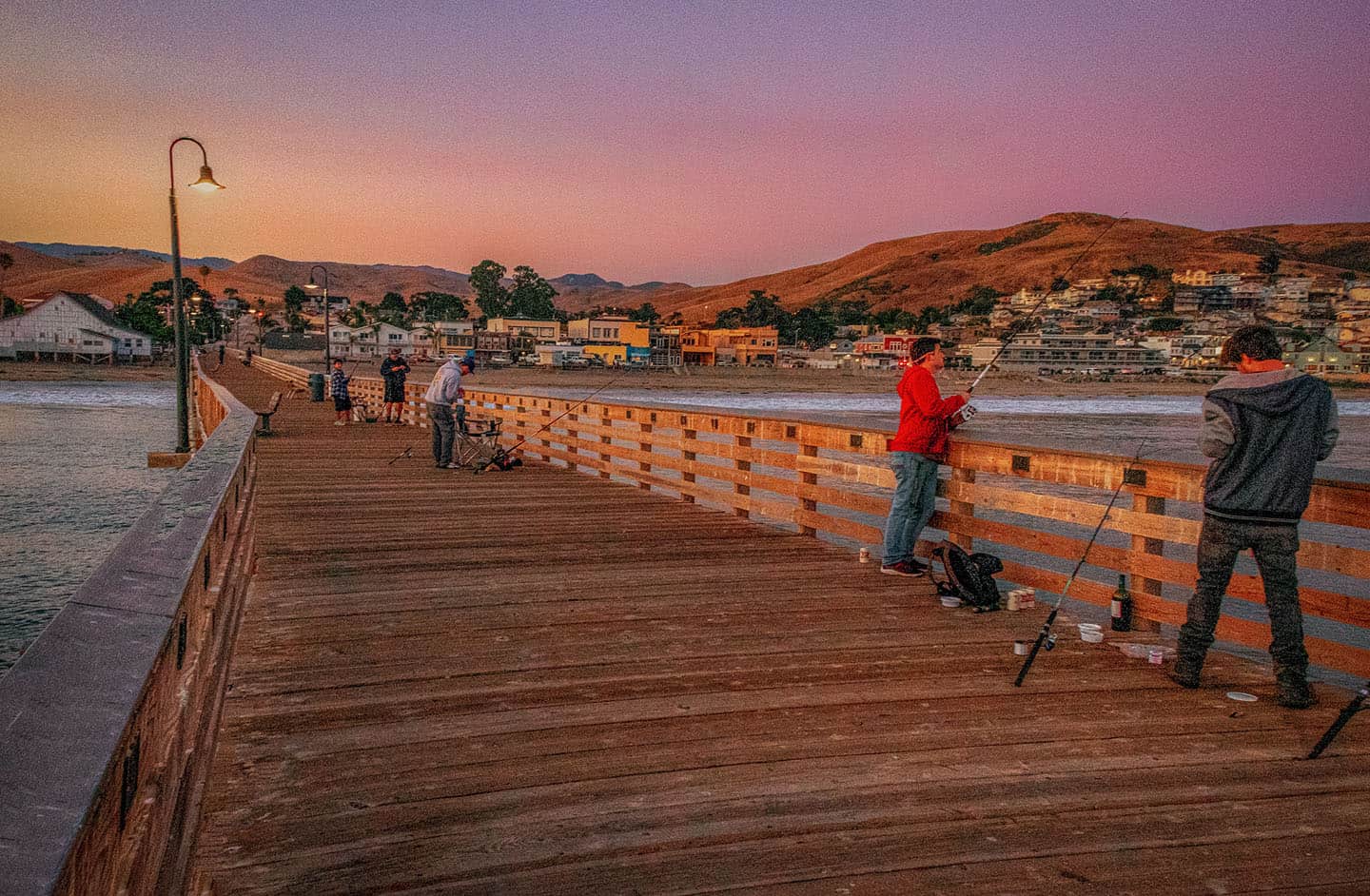
Beaches North of the Pier
Several beach access points along Studio Drive and 24th Street in Cayucos offer excellent terrain for surf casting without the fishing pressure found in more well-known spots. Look for deep troughs between waves during high tide—these natural channels concentrate fish movement and increase your chances of connecting with barred surfperch, corbina and bat rays.
The quieter atmosphere along these stretches of sand allows you to truly immerse yourself in the California surf fishing experience. Pack a beach chair, a small cooler and plan to spend a leisurely day as the rhythmic percussion of waves becomes the soundtrack to your fishing adventure.

Whale Rock Reservoir (Freshwater)
Just a short drive inland from the coast sits this hidden freshwater gem, offering a complete change of pace from saltwater angling. This serene lake nestled among rolling hills provides shore fishing opportunities for bass, bluegill and catfish in a setting far removed from coastal winds.
Unlike many California lakes, Whale Rock doesn’t offer boat ramp access—limiting fishing to shoreline casting or float tubes. This restriction means lighter fishing pressure and a more peaceful experience than you’ll find at larger, more developed lakes. The calm, scenic setting draws locals who appreciate solitude and the chance to fish waters that see very little traffic compared to nearby coastal spots.
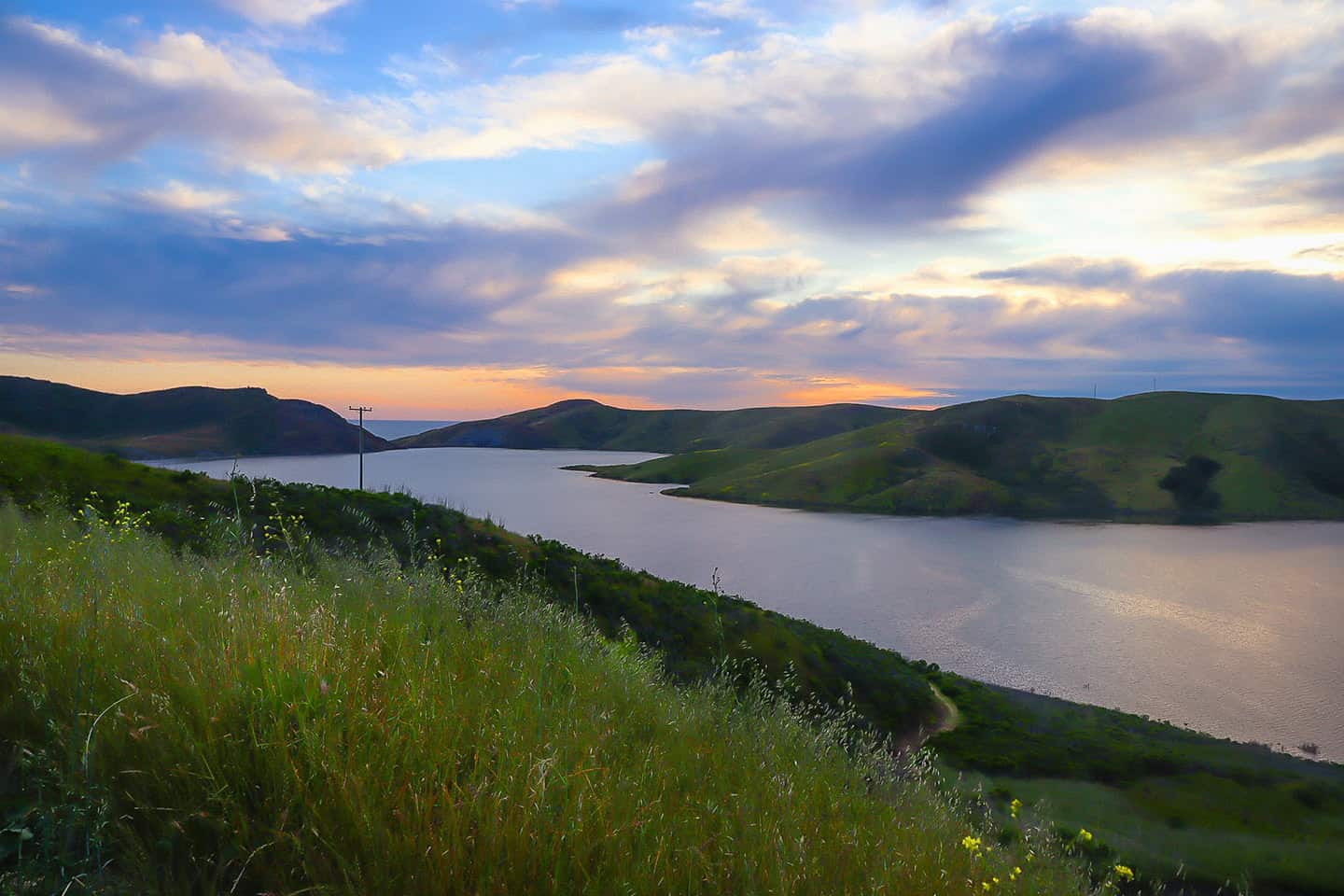
Los Osos
Hazards Canyon
Tucked between cliffs, this rocky pocket beach inside Montaña de Oro State Park is great for rocky surf species. Accessed via a short trail from the Hazards trailhead, you’ll find an intimate fishing experience far from the typical tourist paths. Look for lingcod and perch near rocky outcrops where the underwater geography creates natural fish havens.
Use caution here—waves can crash onto rocks without warning, particularly during changing tides. The extra effort required to reach this spot means you’ll often have it all to yourself, even during peak season. For avid California Coast fishing enthusiasts, the solitude and untapped potential make the hike worthwhile.
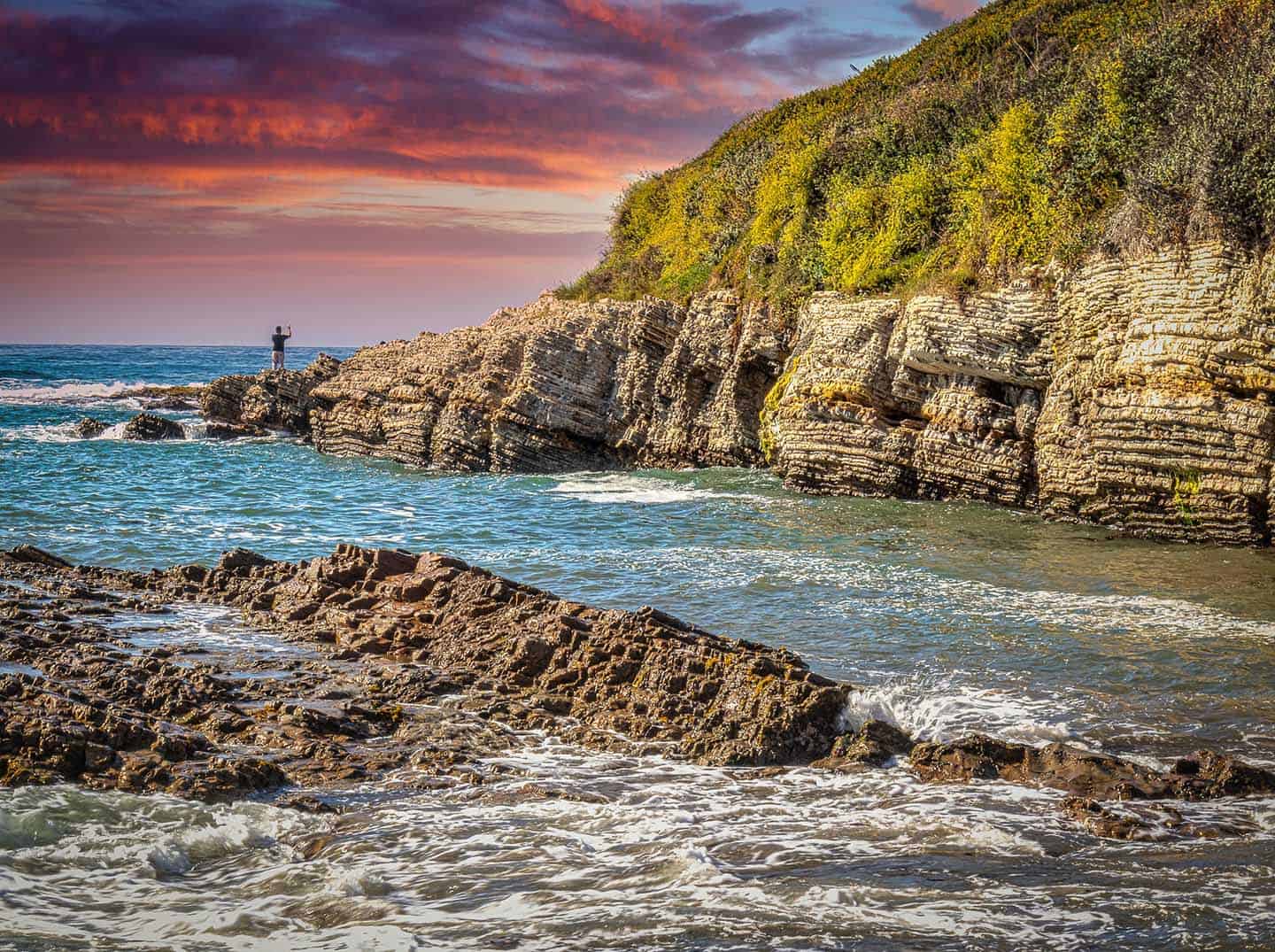
Sandspit Beach
This long, remote stretch of beach facing Morro Bay’s harbor mouth offers some of the most productive surf fishing along Highway 1. You’ll find Sandspit Beach is great for surfperch and halibut, especially on the incoming tide, when these species actively feed in the swirling currents where bay meets ocean.
The journey across sand dunes to reach this beach deters casual visitors, rewarding those willing to make the trek with peaceful surroundings and minimal competition for prime casting spots. Pack light but thoroughly—there are no services nearby and you’ll want to be self-sufficient for your day of fishing.
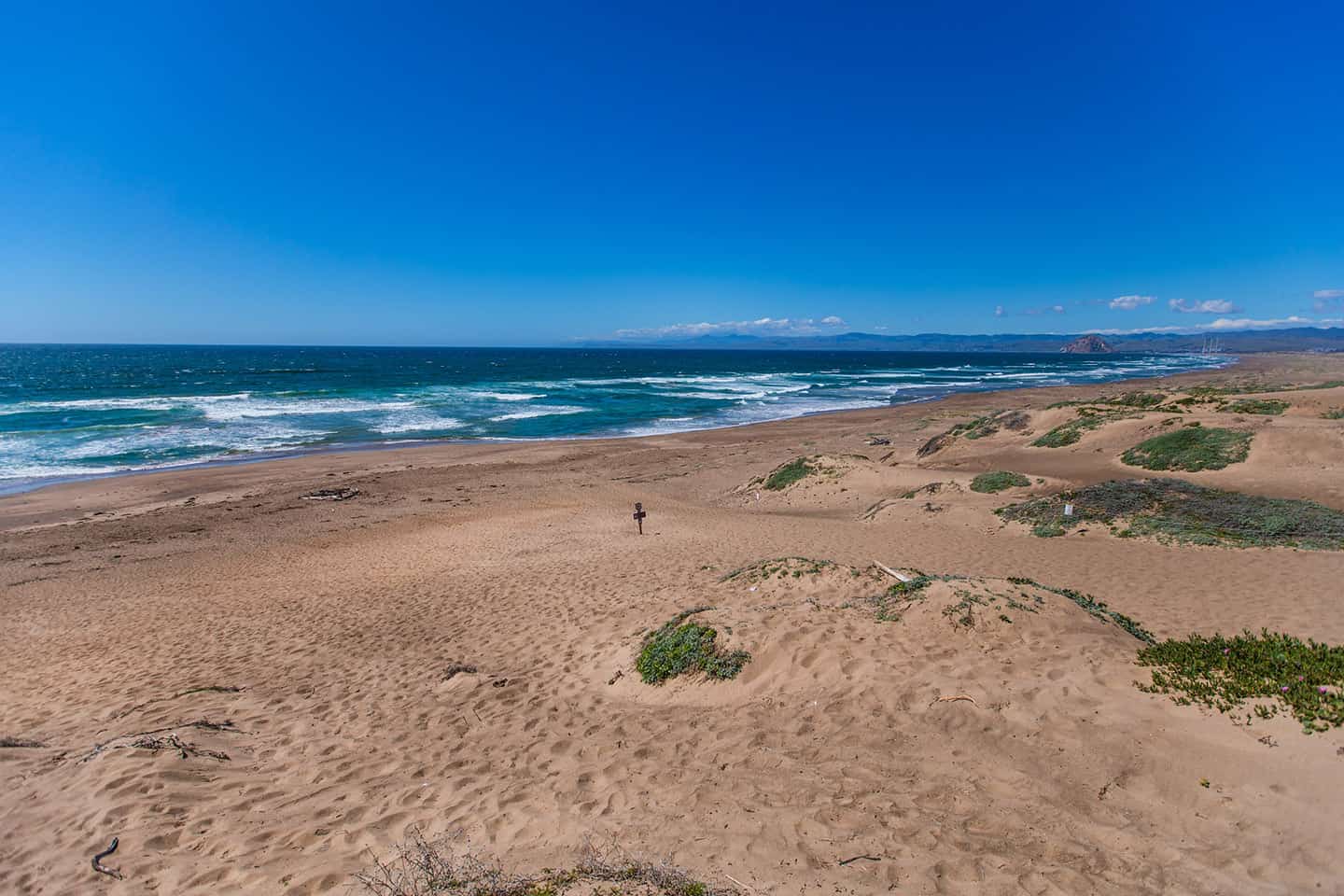
Bluff Trail Access Points
Hidden pullouts along the winding highway reveal rocky ledges where you can cast your line far from the crowds. These secret spots offer not just solitude but prime fishing for curious greenling, vibrant rockfish and hefty surfperch that swarm around the submerged stone formations.
Perched on these coastal bluffs, you’ll gain nature’s advantage—spotting silvery schools and promising structures before your lure touches water. Bring polarized sunglasses to pierce the ocean’s glare and read the water like a seasoned local. These pristine vantage points deliver some of the Central Coast’s most authentic fishing experiences, where it’s just you, your thoughts and the rhythmic dance between angler and ocean.
Important Notes:
- Conditions at these beaches can be challenging and surfaces often slippery—exercise caution and check tides before venturing out.
- These pristine areas have no nearby services—bring all necessary gear, water, and snacks, and always follow Leave No Trace principles to preserve this natural treasure.
- The estuary is a protected wildlife sanctuary—no fishing permitted within its boundaries to safeguard this delicate ecosystem.
- For trail maps, current conditions, and additional information, visit the Montaña de Oro State Park official website before your journey.
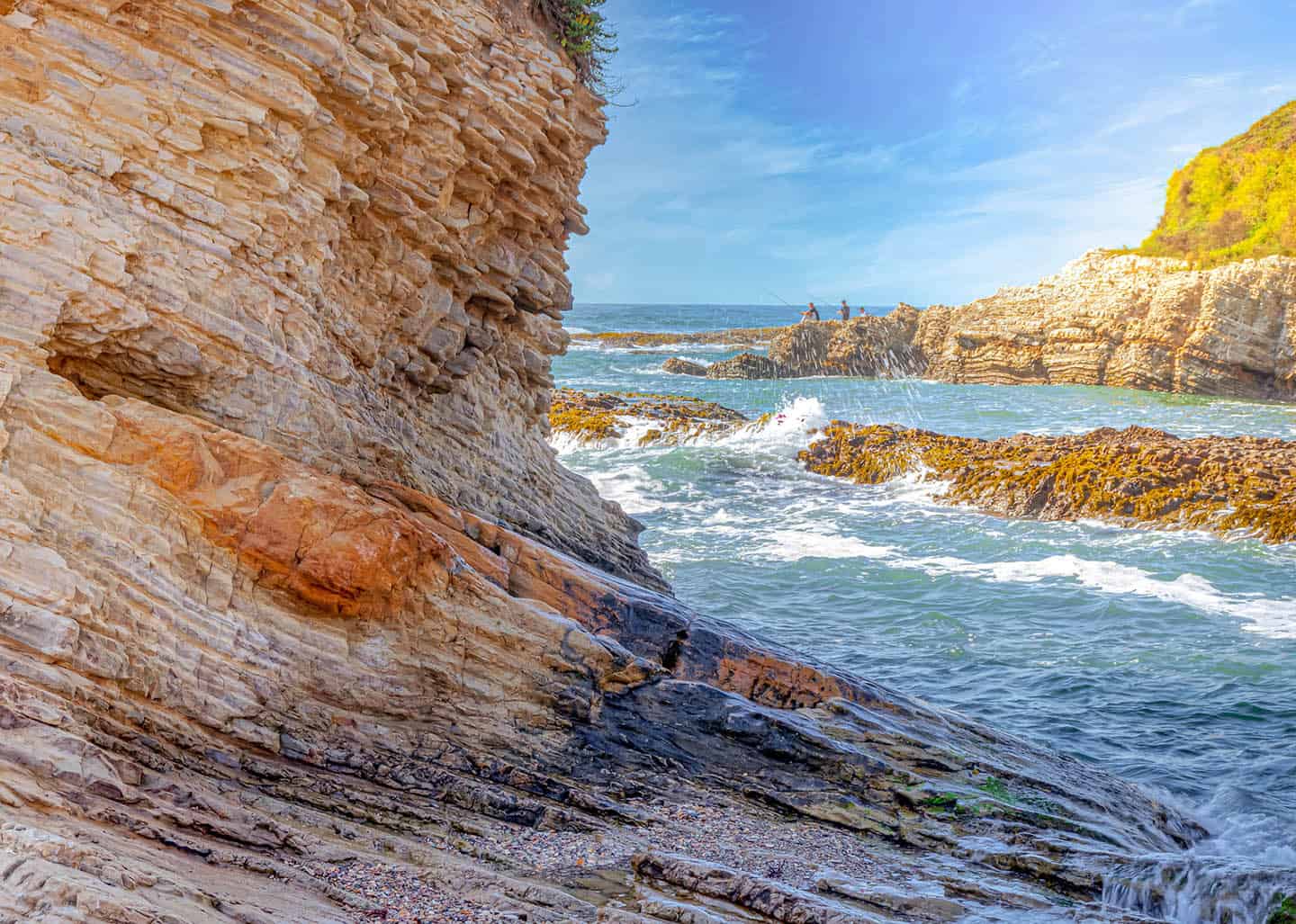
Edna Valley & Arroyo Grande Valley
Lopez Lake (Freshwater)
This inland reservoir offers a complete change of pace when coastal fog or afternoon winds make beach fishing less appealing. Popular for bass, catfish, bluegill and crappie, Lopez Lake provides reliable action even when ocean conditions are challenging.
Boat rentals and a full-service marina make this an accessible option for visitors who don’t have their own watercraft. Shoreline access points accommodate day visitors who prefer to keep their feet on solid ground while fishing. The surrounding oak-studded hills create a scenic backdrop that feels worlds away from the nearby Pacific.
Beyond fishing, families appreciate the additional amenities—hiking trails, picnic areas and camping facilities make Lopez Lake a destination worth exploring between your Highway 1 fishing stops.
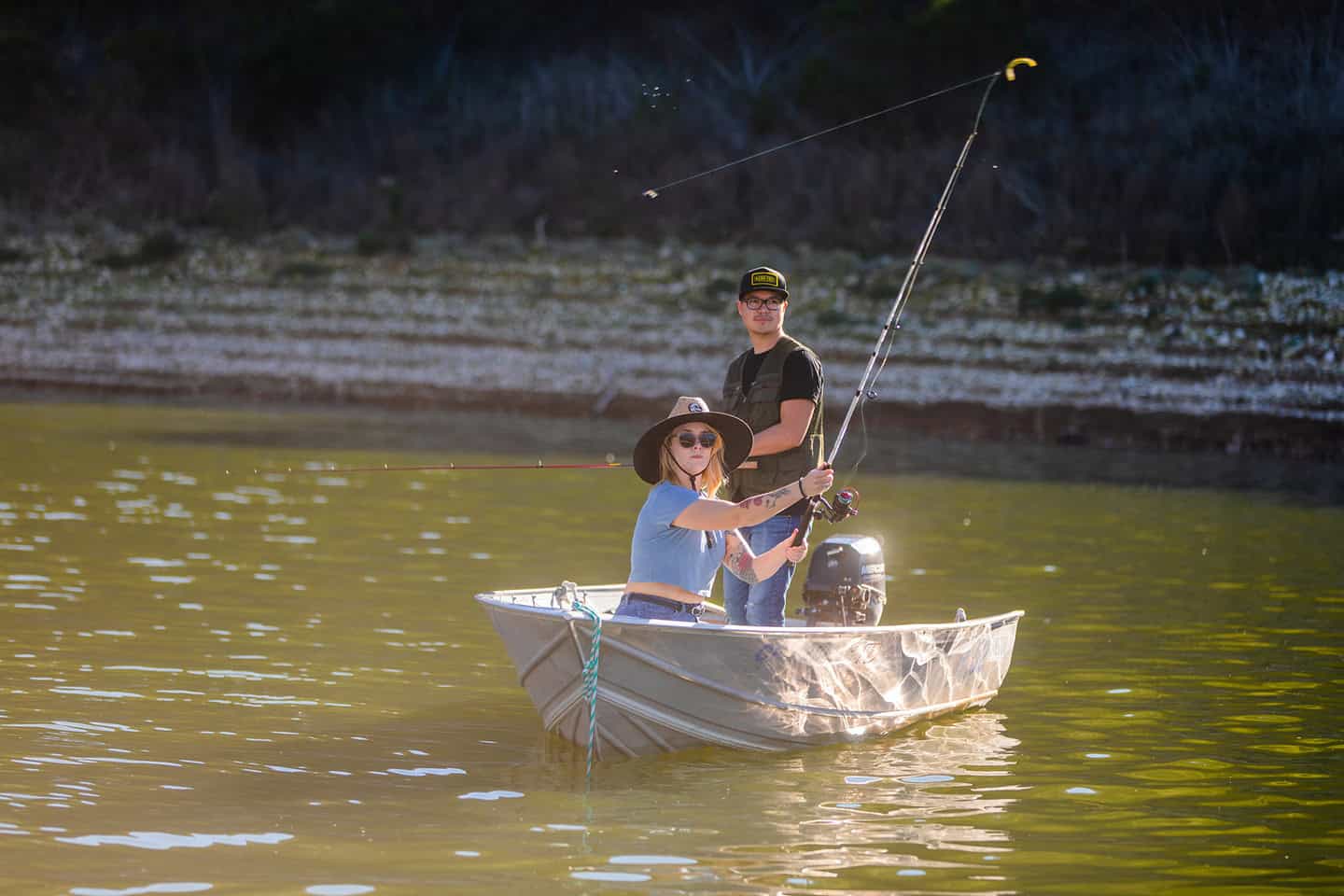
Avila Beach
Avila Pier
This spacious pier welcomes anglers of all experience levels with the added bonus of no license required—perfect for fitting some fishing into your Highway 1 journey without advance planning. The clear waters below attract a steady parade of mackerel, smelt and surfperch throughout the seasons, making every cast an opportunity.
Early mornings and evenings offer the best fishing as the creatures below begin their feeding rituals, and you’ll enjoy more elbow room before the day’s visitors arrive. Even during busier summer months, the pier’s generous width creates a comfortable atmosphere where you can set up your gear, soak in the ocean views and experience that special blend of relaxation and anticipation that makes pier fishing such a beloved pastime along the Central Coast.

Harford Pier (Port San Luis)
One of California’s most unique fishing experiences awaits at this working pier with drive-on access. The rare opportunity to fish directly from your vehicle makes this spot particularly appealing during inclement weather or for those with mobility challenges.
Known for delivering exciting catches including sharks, rays, rockfish (and sometimes halibut), Harford Pier offers access to deeper water than many coastal fishing spots. Its proximity to fish markets and boat charters creates a authentic maritime atmosphere—you’ll cast your line alongside commercial fishermen bringing in the day’s catch!
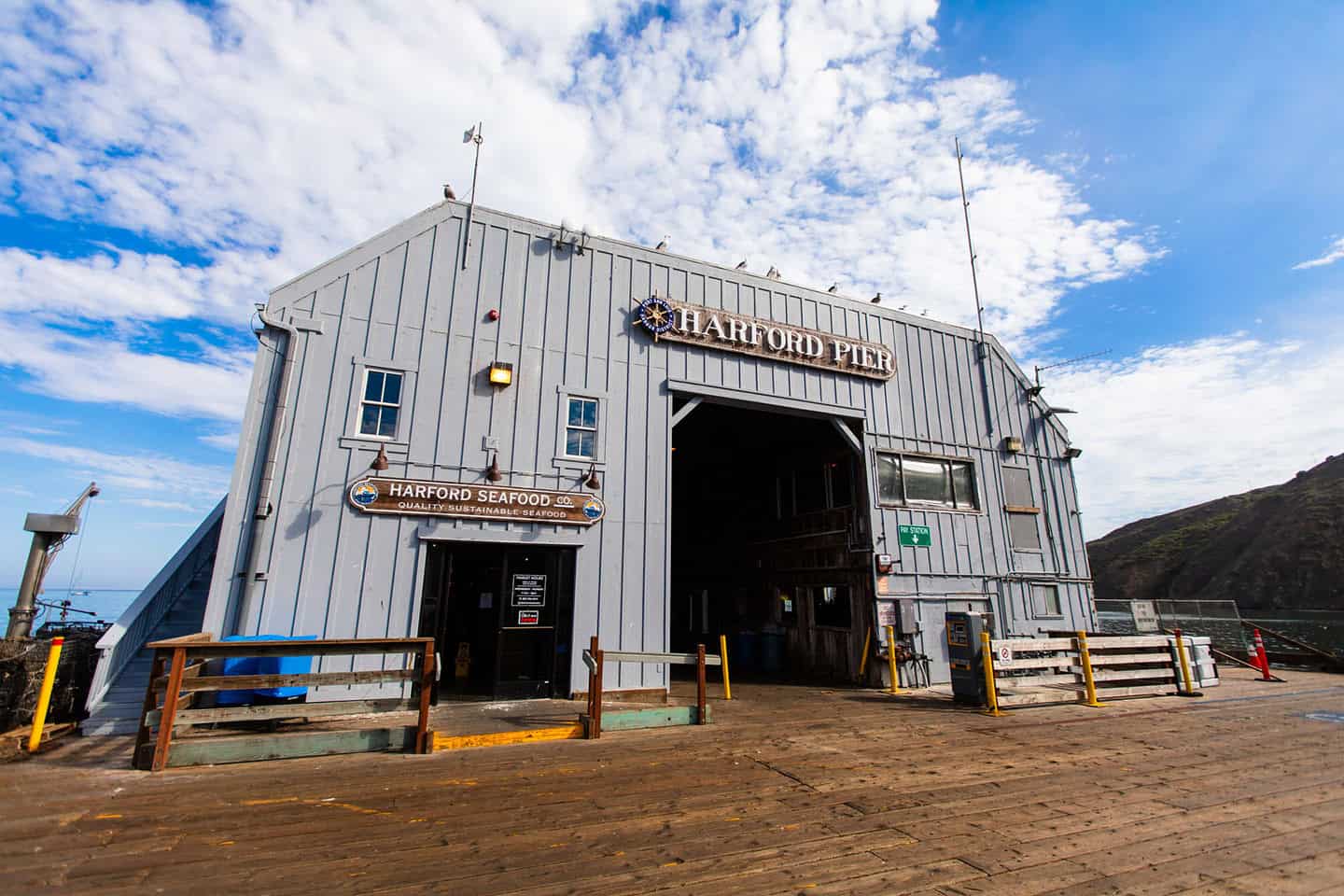
Olde Port Beach (Kayak Launch)
This flat, protected beach provides the ideal starting point for kayak anglers looking to explore the productive waters near Port San Luis. The easy entry point and typically calm conditions make it accessible for beginners while still offering quick access to fishing grounds that seasoned anglers appreciate.
From here, you can paddle to nearby kelp beds and reefs near the breakwater where various rockfish species congregate. The relatively protected waters allow for year-round fishing even when open ocean conditions might be too challenging elsewhere along Highway 1.
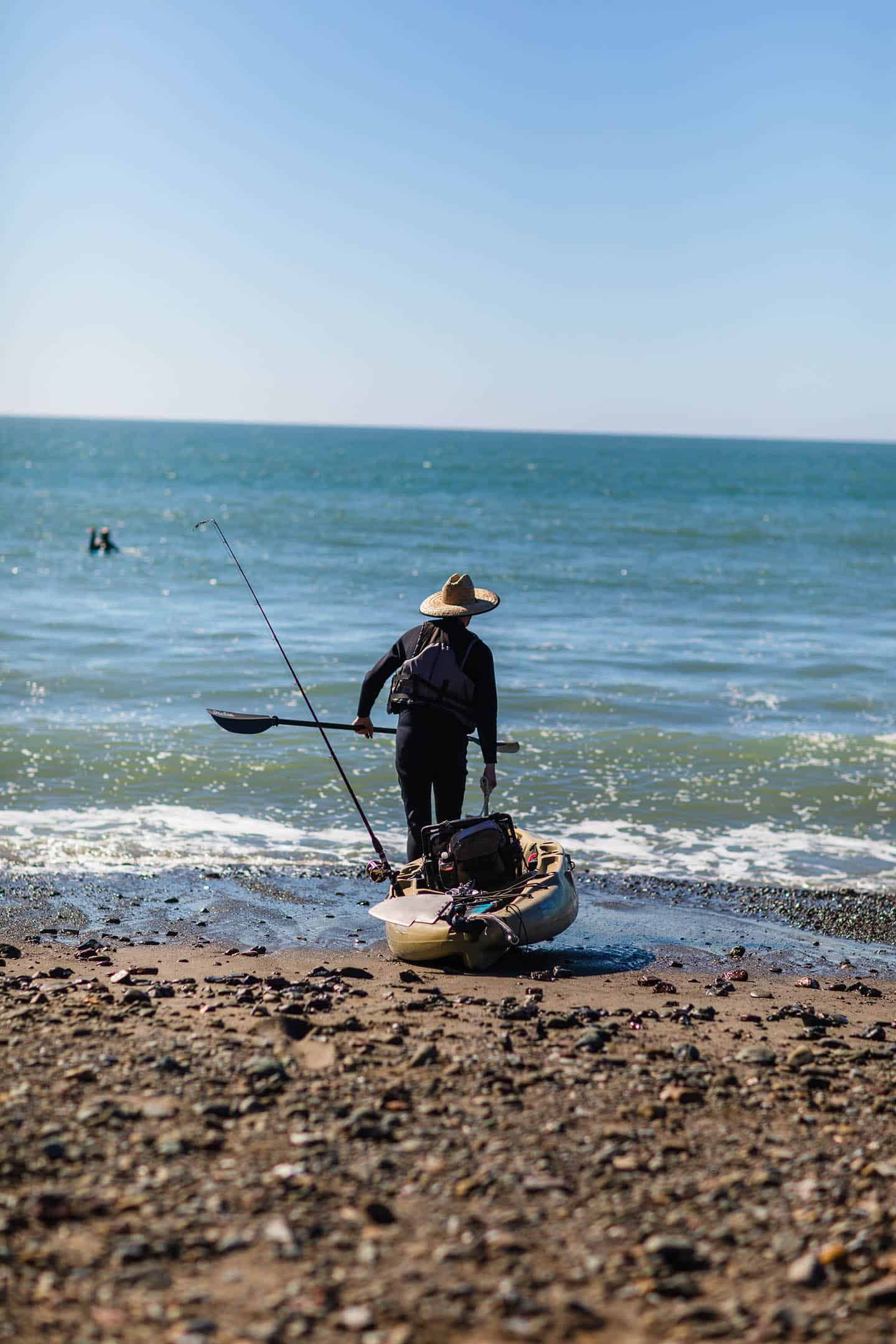
Oceano & Nipomo
Oso Flaco Lake (Freshwater)
This hidden coastal lake offers a completely different fishing experience via a scenic boardwalk that winds through windswept dunes and dense reed habitat. As you stroll toward the water, the wooden planks beneath your feet create a creaking soundtrack while birds dart among the native vegetation surrounding you.
The freshwater environment provides excellent opportunities for bass and bluegill fishing in a setting that feels worlds apart from the nearby ocean. Bring a float tube to access the deeper sections where larger fish tend to congregate, or simply cast from the shoreline where the boardwalk meets the water’s edge.
The tranquil setting makes Oso Flaco a perfect option when you’re craving a peaceful day away from coastal winds. Just remember to pack extra water and snacks—you’re in a remote section of the Central Coast California landscape with minimal services nearby.
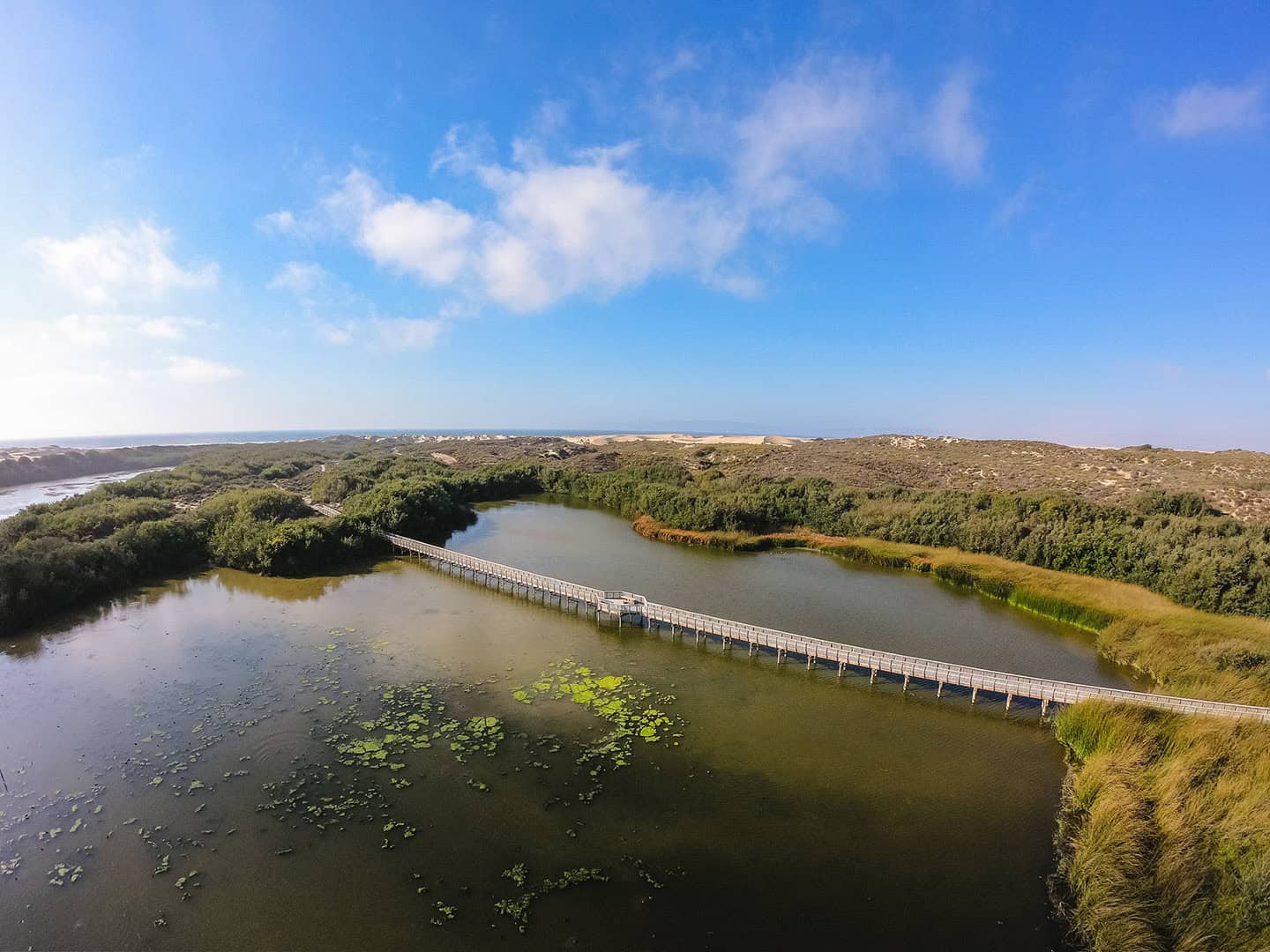
Oceano Dunes
For surf fishing enthusiasts seeking solitude and space, the extensive beach stretching south from Pier Avenue entrance offers some of the most productive yet uncrowded fishing along Highway 1. Here, where the waves roll onto shore without interruption for miles, you’ll find barred surfperch, corbina and rays patrolling the sandy bottom.
Access this stretch either by foot or by 4WD vehicle when permitted (check current regulations before your visit, as vehicle access rules change seasonally). The extra effort to reach the less-visited southern sections rewards you with pristine stretches of California Coast fishing where you might cast for hours without seeing another angler.
Dawn brings particularly magical moments here, when the slanting light illuminates the water and fish actively feed in the shallows. While hunting for the perfect spot, keep your eyes open for sand dollars, intact shells and other beach treasures that often wash ashore along this wild stretch of coastline.
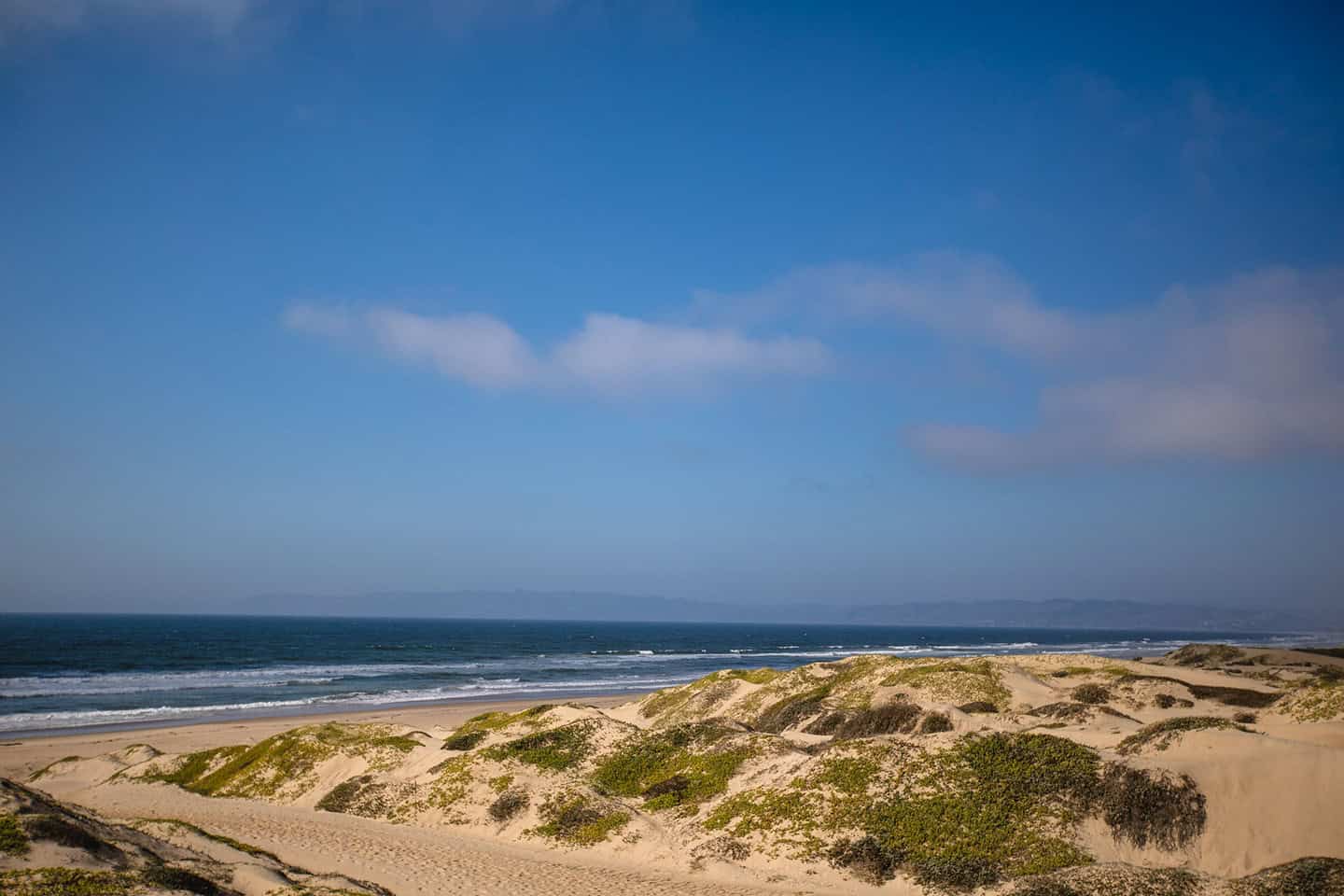
Morro Bay
Morro Bay offers a distinctive coastal fishing experience, where the iconic Morro Rock watches over a protected harbor rich with marine life. While this popular spot attracts many anglers seeking shelter from oceanside winds, those craving genuine solitude can head just minutes north to Cayucos, where pristine, largely untouched beaches stretch for miles with only occasional footprints marking the sand.
For an even more secluded retreat, the hidden coves of Montana de Oro to the south provide a wilderness fishing experience where you might not see another soul all morning. The rugged, dramatic coastline here offers not just exceptional fishing but also the restorative peace that comes from connecting with nature far from crowds. Remember that specific regulations apply within Morro Bay’s Marine Recreational Management Area, but the untamed shores of these neighboring areas offer both freedom and tranquility—perfect for anglers seeking authentic Highway 1 fishing in its most natural state.
When you’re ready to change scenery, drive just minutes north to the beaches near Cayucos or south toward Montana de Oro where stunning, uncrowded shorelines offer plenty of elbow room for casting into the rolling Pacific surf.

When to Fish (Tides, Seasons, Species)
Best Fishing Seasons by Species
Surfperch (especially barred surfperch)
- Peak Season: Winter to early Spring (December to April)
- Bites best during outgoing tides and just before low tide
- Prime locations: Oceano, Sandspit, and Moonstone beaches
California Halibut
- Peak Season: Late Spring to early Fall (May through September)
- Prefers sandy bottoms near piers and estuary mouths
- Hot spots: San Simeon Pier and Avila Pier
- Most active during early morning or late afternoon
Lingcod & Rockfish
- Peak Season: May through December (recreational groundfish season)
- Found near rocky reefs, often targeted from kayaks
- Productive areas: Leffingwell Landing, Hazards, and Port San Luis
Striped Bass
- May appear during summer months near estuaries
- Occasional sightings near Morro Bay and Oso Flaco
Sharks, Jacksmelt, Mackerel
- More active in warmer months (Spring to early Fall)
- Commonly caught from piers: Cayucos, Avila, and Harford
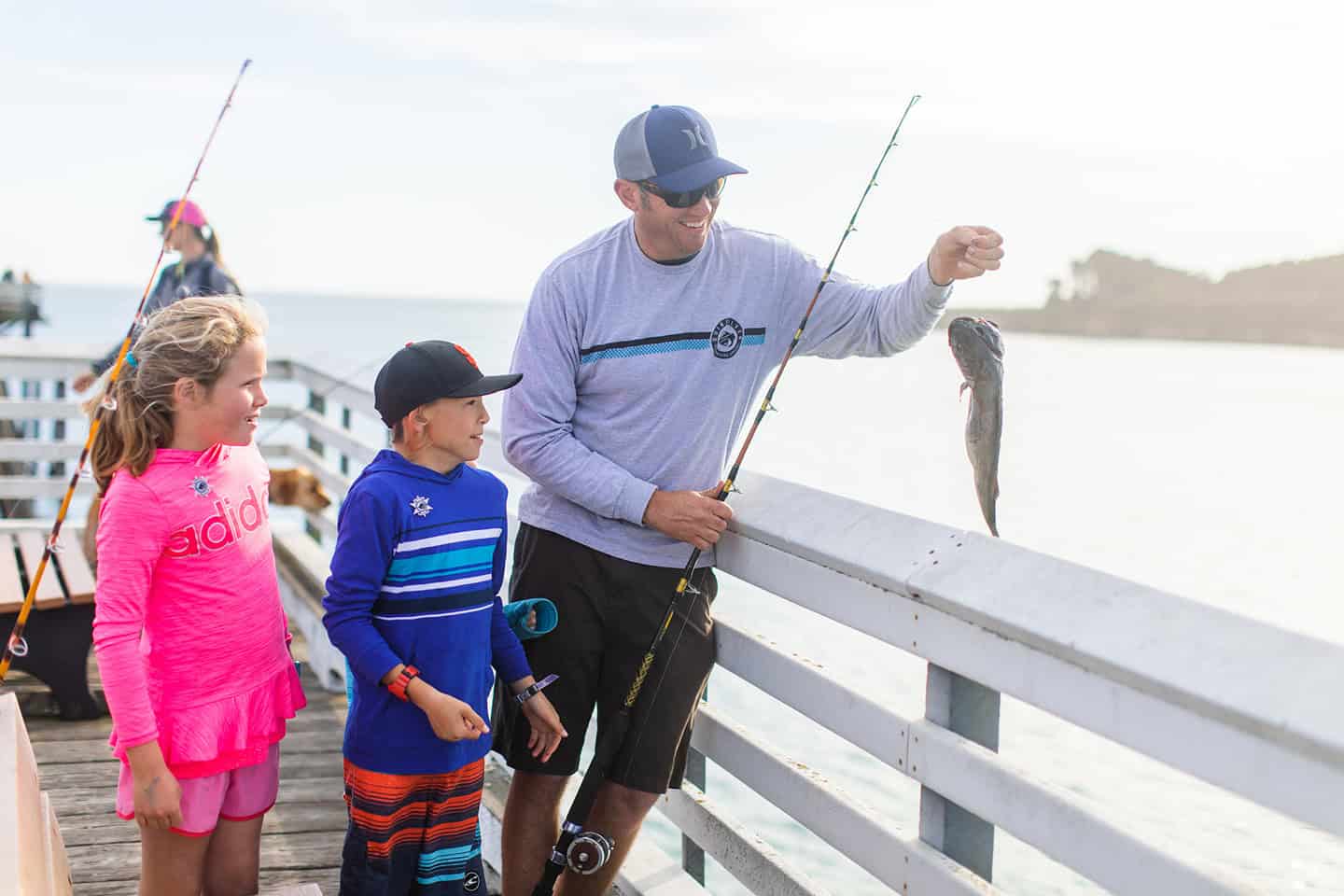
Tide Timing
Timing truly matters when fishing Highway 1. The magic typically happens during tide transitions—especially 1-2 hours before or after high tide for surf fishing. Planning your fishing around these windows dramatically increases your chances of success. Check local tide charts before heading out to maximize your fishing experience.
Where to Get Licenses, Bait & Local Insight
California fishing licenses are required for all fishing except when on public piers. Purchase licenses online through the California Department of Fish & Wildlife, or in person at these local outfitters:
- Patriot Sportfishing (Avila Beach) – Also offers chartered trips, tackle, and local fishing reports
- Virg’s Landing (Morro Bay) – Complete tackle shop with expert advice on current conditions
- Central Coast Kayaks / Avila Beach PaddleSports – Kayak rentals and guidance on best launch sites
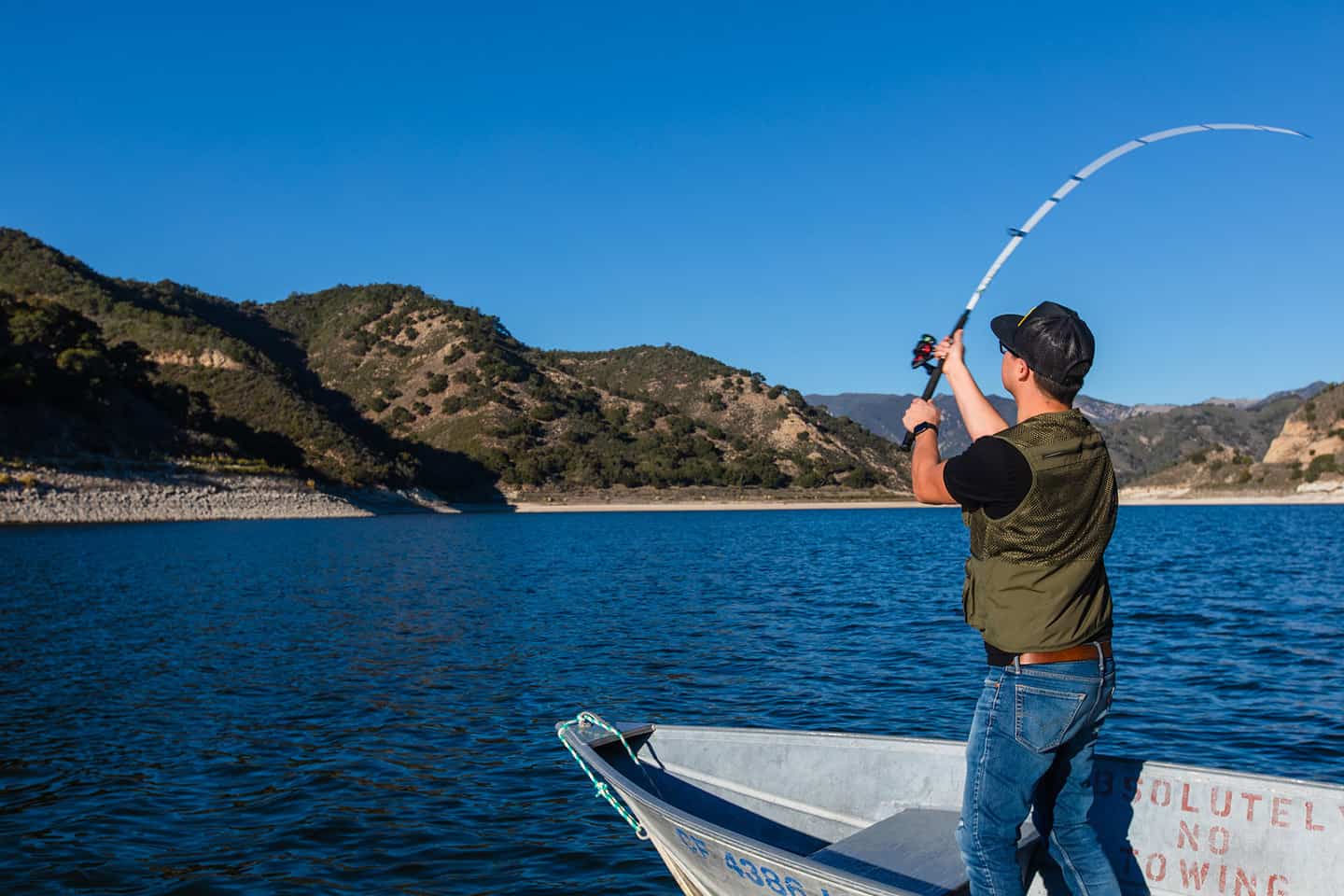
Regulations & Responsible Fishing
License Requirements
Feel that anticipation of the first nibble? Before you experience that thrill, you’ll need a California fishing license for almost any spot you choose along Highway 1.
The exception? Those charming public piers that dot our coastline—places like Cayucos Pier where families gather with fishing rods at sunset, or the historic Avila Pier where you might spot dolphins playing in the distance. From these community gathering spots, you can fish license-free.
For everywhere else, you’ll want to secure your license online through the California Department of Fish & Wildlife Licensing portal. It’s a quick process that helps protect the very ecosystem you’re about to enjoy.
Fishing Regulations
As you cruise along Highway 1, windows down and salt air tousling your hair, you’re traveling through the California Ocean Sport Fishing Zone’s Central Management Area. This stretch of coast comes with some important guidelines to ensure everyone—including future generations—can experience the joy of a fresh catch.
Daily bag limits keep our ocean balanced, while size requirements mean those smaller fish get a chance to grow up and perhaps meet your line another day. Seasonal closures protect species like lingcod during crucial breeding times, and some spots along the route have specific rules about bait or gear.
Before heading out, take a quick look at the Central California Ocean Fishing Regulations—a small step that makes a big difference in preserving the coastal ecosystem you’ve come to explore.
Marine Protected Areas (MPAs)
As you meander along Highway 1, you’ll notice special havens where marine life thrives in protected sanctuary. These Marine Protected Areas are nature’s nurseries—places where fish populations rebuild and ecosystems flourish. You’ll spot signs marking these zones when you pull over at beaches and coastal access points.
Throughout your journey, you’ll pass by several of these underwater treasures: the Morro Bay State Marine Reserve where fishing isn’t permitted but tidepooling adventures await; the Cambria State Marine Conservation Area where limited fishing follows specific species guidelines; the rugged Point Buchon State Marine Reserve closed to fishing but offering spectacular hiking; and further south near Nipomo, the Vandenberg State Marine Reserve where all marine harvesting is prohibited.
As you explore, you’ll want to respect the posted signs that mark these special places, avoid casting your line in no-take zones and perhaps dive deeper into understanding these protected areas through the California Marine Protected Areas Interactive Map—a great companion for planning your coastal adventure.
Responsible Fishing Tips
The morning fog lifts to reveal a coastline teeming with life—from otters cracking shells on their bellies to shore birds darting along the tideline. When you fish these waters, you become part of this delicate dance of nature.
Keep the experience pristine for those who follow in your footsteps by packing out all your trash, fishing lines and bait containers. In conservation zones, barbless hooks make catch-and-release gentler on the fish. As you explore, tread lightly around tidepools—these miniature ecosystems are more fragile than they appear.
The wildlife viewing along Highway 1 is unmatched, but remember to keep a respectful distance from the local residents—sea otters wrapped in kelp, harbor seals lounging on rocks and shorebirds tending to well-camouflaged nests in the sand. These respectful practices ensure your fishing memories along Highway 1 will be as sustainable as they are unforgettable.

Trip Planning Resources
As your journey along Highway 1 winds to a close, you’ll carry home more than just a cooler of fresh catch—you’ll have memories of fishing spots where crowds are replaced by circling pelicans and the calming crash of waves. From the rocky shores of San Simeon where lingcod await in kelp forests to the gentle surf of Pismo Beach where perch dance in the shallows, Highway 1 offers some of California’s most varied and productive fishing experiences without the elbow-to-elbow frustration of more trafficked spots.
The fishing rod might be what brought you here, but don’t be surprised if you find yourself extending your stay to explore more of what makes this coastline special. When planning your ultimate coastal fishing getaway, you’ll want to check out where to stay Along Highway 1 for accommodations that range from oceanfront cottages where you can fall asleep to the sound of the sea to family-owned inns just steps from prime fishing spots.
Between fishing adventures, treat yourself to one of the best scenic drives where each turn reveals another postcard-worthy vista that will have you pulling over to simply breathe it all in. And don’t miss the Historic Piers and Lighthouses that not only offer fantastic fishing opportunities but also tell the maritime stories of this rugged, beautiful stretch of California that’s been enchanting anglers for generations.



